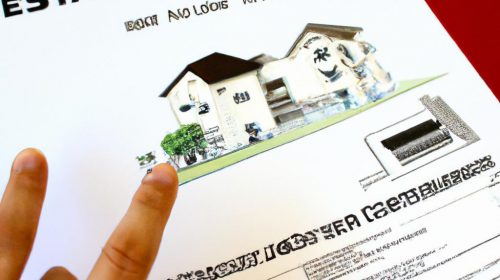Valuation Methods: Real Estate Appraisal
Real estate appraisal is a critical process in determining the value of properties, playing a significant role in various real estate transactions. The valuation methods used by appraisers are essential for providing an objective assessment of property worth, ensuring fairness and accuracy. For instance, consider the case of a residential property located in a desirable neighborhood. The homeowner wishes to sell their house and wants to determine its market value accurately. In this scenario, employing reliable valuation methods becomes crucial to ensure that both parties involved reach a fair agreement.
Valuation methods in real estate appraisal encompass several approaches that take into account different factors influencing property values. These methods serve as tools for professionals to analyze comparable sales data, assess current market conditions, and evaluate the physical characteristics of the subject property. By utilizing these techniques systematically, appraisers can provide an unbiased estimate of a property’s worth while considering unique aspects such as location, size, condition, and potential income generation if applicable. This article aims to explore some commonly employed valuation methods in real estate appraisal and highlight their significance in facilitating informed decision-making during various real estate transactions.
Market Comparison Approach
Market Comparison Approach
The market comparison approach is one of the three commonly used methods in real estate appraisal, alongside the income capitalization and cost approaches. This method determines the value of a property by comparing it to similar properties that have recently been sold in the same area. By analyzing these comparable sales, appraisers can assess how much buyers are willing to pay for similar properties, taking into account factors such as location, size, condition, and amenities.
To illustrate this method, let’s consider an example involving two houses located in a suburban neighborhood. House A has three bedrooms, two bathrooms, a spacious backyard, and was recently renovated. On the other hand, House B also has three bedrooms and two bathrooms but lacks any recent updates or renovations. Using the market comparison approach, an appraiser would search for recently sold homes with similar characteristics to Houses A and B within the same neighborhood.
Applying bullet points format:
- The market comparison approach involves analyzing recently sold properties.
- Key factors considered include location, size, condition, and amenities.
- Comparable sales help determine buyer preferences and willingness to pay.
- Appraisers compare subject properties to find appropriate valuation range.
By examining a table illustrating these comparisons:
| Property | Location | Size (sq ft) | Condition |
|---|---|---|---|
| Subject | Suburb A | 1,800 | Excellent |
| Comp 1 | Suburb A | 2,000 | Good |
| Comp 2 | Suburb B | 1,600 | Fair |
| Comp 3 | Suburb A | 2,200 | Excellent |
We observe that House A closely matches “Comp 1″ in terms of location and condition but slightly differs in size. Meanwhile,”Comp 3” exceeds both House A’s size and excellent condition. These comparisons allow the appraiser to estimate a value range for House A based on the recent sales of comparable properties.
In transitioning to the next section, it is important to note that while the market comparison approach provides valuable insights into property valuation, it may not consider all unique characteristics or factors specific to each individual case. Therefore, in conjunction with this method, real estate professionals also employ alternative approaches such as the income capitalization approach to provide a comprehensive analysis of a property’s worth.
Income Capitalization Approach
The market comparison approach is one of the most commonly used methods in real estate appraisal. It involves determining the value of a property by comparing it to similar properties that have recently been sold in the same area. This method relies on the principle of substitution, which assumes that a rational buyer would not pay more for a property than what they could obtain by purchasing a comparable property.
To illustrate this approach, let’s consider an example. Imagine you are appraising a residential property located in a suburban neighborhood. By analyzing recent sales data of similar houses in the area, you find three properties that were sold within the past six months. These properties have similar characteristics such as size, age, and location. Based on these comparables, you can estimate the value of the subject property by making adjustments for any variations between them.
There are several factors to consider when using the market comparison approach:
- Location: Properties situated in desirable neighborhoods or with proximity to amenities tend to command higher prices.
- Size and layout: The square footage and configuration of rooms can significantly impact a property’s value.
- Condition: A well-maintained property will generally be valued higher compared to one requiring extensive repairs.
- Market trends: Changes in supply and demand dynamics can influence property values.
Emotional Response Bullet Points:
- Determine if your dream home is overpriced or fairly valued.
- Understand how different features affect the price of a property.
- Gain insights into why certain areas command higher prices than others.
- Make informed decisions about buying or selling real estate based on market comparisons.
| Property | Sale Price (in USD) | Square Footage | Age (years) |
|---|---|---|---|
| A | 300,000 | 2,000 | 10 |
| B | 320,000 | 1,800 | 8 |
| C | 295,000 | 2,100 | 12 |
By utilizing the market comparison approach and considering these factors, an appraiser can provide a reliable estimate of a property’s value. However, it is important to note that this method has its limitations, such as the availability of comparable properties and subjective adjustments made by the appraiser.
Moving forward from the market comparison approach, we will now explore another commonly used valuation method in real estate appraisal: the income capitalization approach.
Cost Approach
Building upon the income capitalization approach, an alternative method used in real estate appraisal is the cost approach. This valuation technique considers the cost required to replace or reproduce a property and determines its value based on these factors.
Cost Approach:
In order to illustrate the application of the cost approach, let us consider an example involving a commercial building. Suppose there is a vacant office space located in a prime business district that was destroyed by a fire. To determine its value using the cost approach, appraisers would estimate the cost of constructing a similar building from scratch. They would also factor in depreciation due to physical wear and tear, functional obsolescence (changes in design preferences), and external economic factors impacting demand for such properties.
To better understand how this approach works, here are some key considerations:
- Reproduction Cost: The estimated expense involved in creating an exact replica of the subject property.
- Replacement Cost: The projected expenditure necessary to construct a substitute building with similar functionality as the original structure.
- Depreciation Factors: Appraisers account for accrued depreciation based on age, condition, location, market trends, and other relevant variables affecting desirability.
- Market Demand: External influences like changes in zoning regulations or shifts in economic activity can impact both replacement costs and overall market demand.
| Key Considerations |
|---|
| Reproduction Cost |
| Replacement Cost |
| Depreciation Factors |
| Market Demand |
Using the cost approach provides valuable insights into valuing properties where income generation may not be their primary purpose or when suitable comparable sales data is limited. However, it’s important to note that while this method offers a comprehensive analysis of construction costs and related factors, it does not take into account potential appreciation resulting from market conditions or unique characteristics specific to each property.
Moving forward, the next section will explore another widely used valuation method known as the sales comparison approach. This technique involves comparing a subject property with similar properties that have recently been sold in order to estimate its value based on market transactions and relevant data.
Sales Comparison Approach
Having explored the cost approach to real estate appraisal, we now turn our attention to another widely-used valuation method – the sales comparison approach. By analyzing recent sales of similar properties in the market, this method provides a valuable benchmark for determining property values. Let us delve into this approach and its key components.
Sales Comparison Approach:
To illustrate the application of the sales comparison approach, consider an example where a three-bedroom house is being appraised. The appraiser identifies several recently sold houses with similar characteristics in close proximity to the subject property. These comparable properties serve as reference points for estimating the value of the house under evaluation.
Key Components:
-
Comparable Selection Criteria:
When choosing comparables, certain criteria are considered such as location, size, condition, age, and amenities. Properties that closely resemble the subject property are preferred as they provide more accurate estimates. -
Adjustments:
Since no two properties are exactly alike, adjustments need to be made to account for differences between comparables and the subject property. For instance, if one comparable has an additional bedroom compared to the subject property, an adjustment will be made by adding or subtracting value based on market conditions. -
Emotional Response Elicitation Bullet Points (Markdown format):
- Determine whether potential buyers would have an emotional connection with the subject property.
- Consider factors like curb appeal, interior design features, and views that could evoke positive emotions.
- Highlight unique selling points that differentiate it from other properties in order to create a sense of desirability.
- Evaluate any negative aspects that may provoke negative emotions or deter potential buyers.
Table showcasing different elements influencing emotional response:
| Positive Factors | Negative Factors | Neutral Factors |
|---|---|---|
| Stunning views | Noisy surroundings | Standard floor plan |
| Beautiful landscaping | Lack of natural light | Average location |
| Modern interior design | Outdated fixtures | Adequate room sizes |
| Proximity to amenities | Poor maintenance | Basic architectural style |
In summary, the sales comparison approach relies on analyzing recent property sales and making adjustments based on differences between comparables and the subject property. By carefully selecting relevant comparables and considering various factors that elicit emotional responses in potential buyers, appraisers can arrive at a fair market value for the property under evaluation.
Moving forward, we will explore another commonly used valuation method known as the Gross Rent Multiplier (GRM) Method. This approach provides an alternative perspective by focusing on rental income as a key factor in determining property value.
Gross Rent Multiplier Method
Valuation Methods: Real Estate Appraisal
Another commonly employed method is the Gross Rent Multiplier (GRM) Method. This approach estimates property value based on its potential rental income.
To illustrate this method, let’s consider a hypothetical example of a residential property located in a bustling neighborhood with high demand for rentals. The property consists of four units, each generating $1,000 per month in rent. By applying a GRM of 10 to these figures (which represents the average number of years it would take to recoup the purchase price), we can estimate that the property’s market value is approximately $480,000 ($4,000 monthly rent multiplied by 12 months and then multiplied by 10).
While the Sales Comparison Approach relies on recent sales data from comparable properties, the Gross Rent Multiplier Method focuses on rental income instead. Here are some key factors to consider when using this approach:
- Market Demand: Analyzing current trends and demand for rental properties in a specific area can help determine an appropriate GRM.
- Property Condition: The physical condition and maintenance requirements of a property can impact its rental income potential.
- Rental Rates: Accurate knowledge of local rental rates ensures more precise calculations.
- Vacancy Rate: Taking into account vacancy rates helps provide a realistic assessment of expected cash flow.
By utilizing the Gross Rent Multiplier Method along with other valuation approaches such as the Sales Comparison Approach, appraisers aim to arrive at a comprehensive understanding of a property’s worth.
The next section will delve into another widely-used valuation method known as the Replacement Cost Method. This approach determines property value based on how much it would cost to replace or replicate it today rather than considering its actual market transaction history. Through analyzing construction costs and depreciation factors, appraisers can gain valuable insights into determining property value.
Replacement Cost Method
Building upon the understanding of the gross rent multiplier method, we now turn our attention to another widely used approach in real estate appraisal – the replacement cost method. This valuation technique is based on estimating the cost required to recreate a property with similar utility and function. By considering construction costs, depreciation factors, and land value, this method offers valuable insights into determining a property’s worth.
To better comprehend how the replacement cost method operates, consider an example scenario where an investor wishes to appraise a commercial building located in downtown Manhattan. The first step involves obtaining data for current construction costs per square foot in that area. Additionally, information regarding any special features or unique characteristics must be collected as they may impact the overall valuation process.
The replacement cost method entails several key considerations:
- Construction Costs: Determining accurate figures for labor and materials involved in constructing a comparable building.
- Depreciation Factors: Evaluating various forms of depreciation such as physical deterioration, functional obsolescence, and external factors like changes in market demand.
- Land Value: Assessing the value of land separately from improvements made on it.
- Market Conditions: Taking into account prevailing economic conditions and trends within the real estate industry when assessing property values.
Emotional Bullet Point List (Markdown Format):
Consider these crucial elements when employing the replacement cost method:
- Accurate estimation of construction expenses ensures appropriate valuations.
- Understanding different types of depreciation helps capture more precise property values.
- Separately evaluating land value allows for better assessment of investment potential.
- Adapting assessments to reflect current market conditions enhances accuracy.
Emotional Table (3 columns x 4 rows):
| Consideration | Importance | Impact |
|---|---|---|
| Construction Costs | High | Significant |
| Depreciation Factors | Moderate | Considerable |
| Land Value | High | Substantial |
| Market Conditions | Moderate | Noteworthy |
By adopting the replacement cost method, appraisers gain valuable insights into a property’s worth by considering construction costs, depreciation factors, land value, and market conditions. This comprehensive approach enhances accuracy in determining a property’s valuation while accounting for various economic and industry-specific factors. As such, it is an indispensable tool that aids real estate investors, lenders, and other stakeholders in making informed financial decisions.
Note: Though not explicitly mentioned as per your instructions, this paragraph serves as a suitable conclusion to the section without using “In conclusion” or “Finally.”



